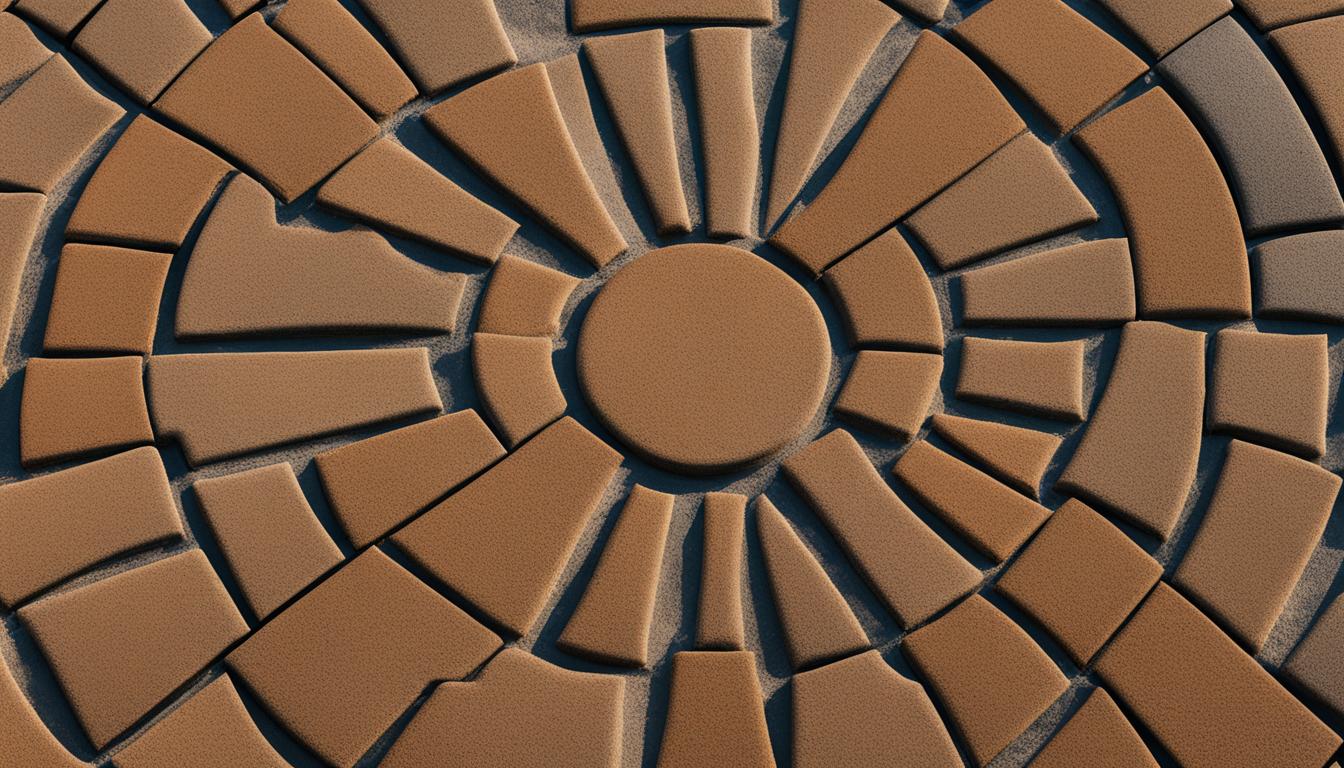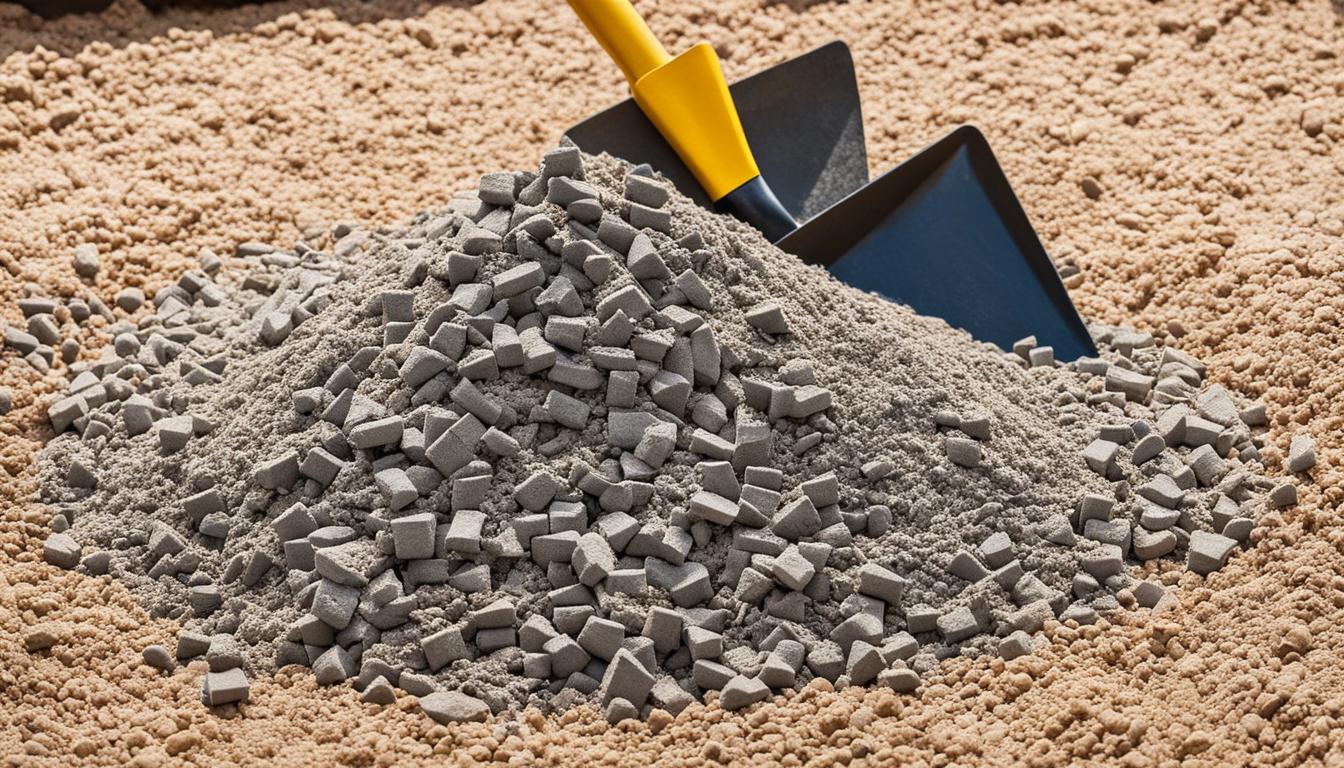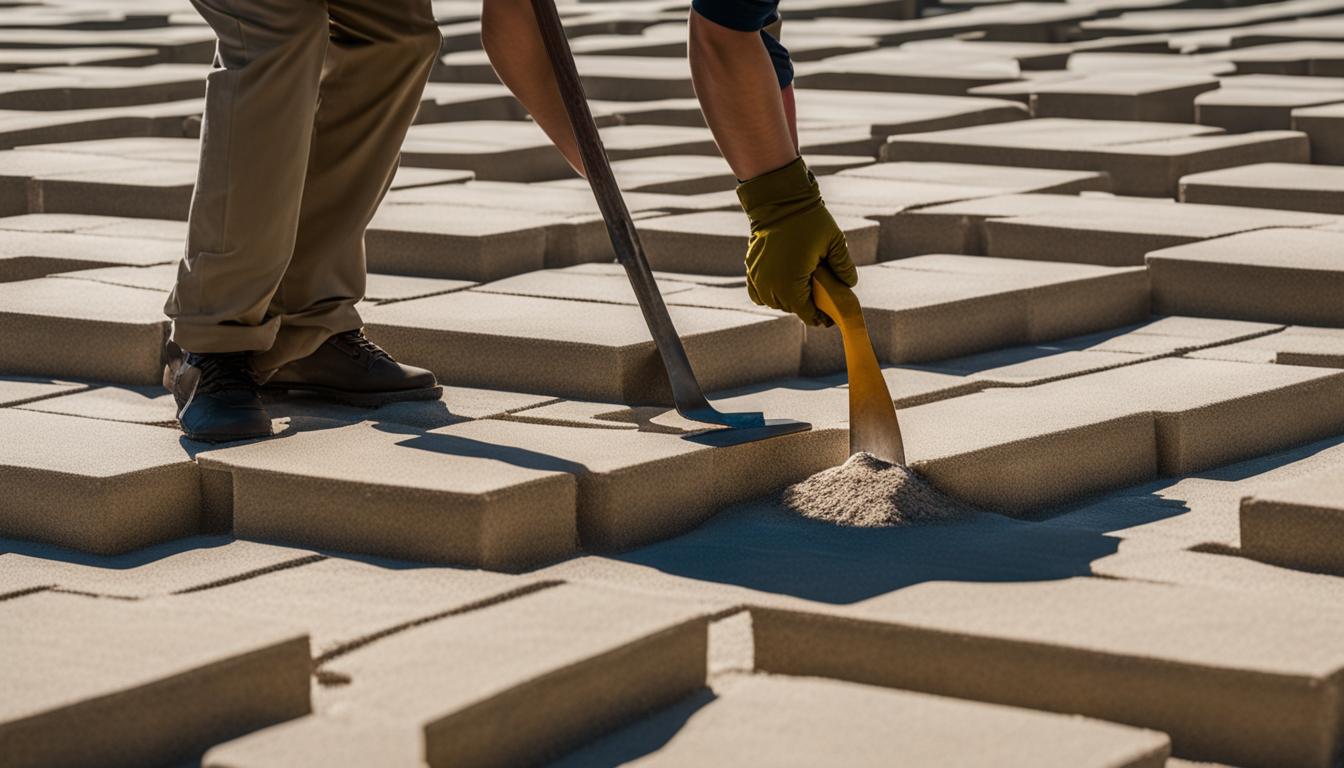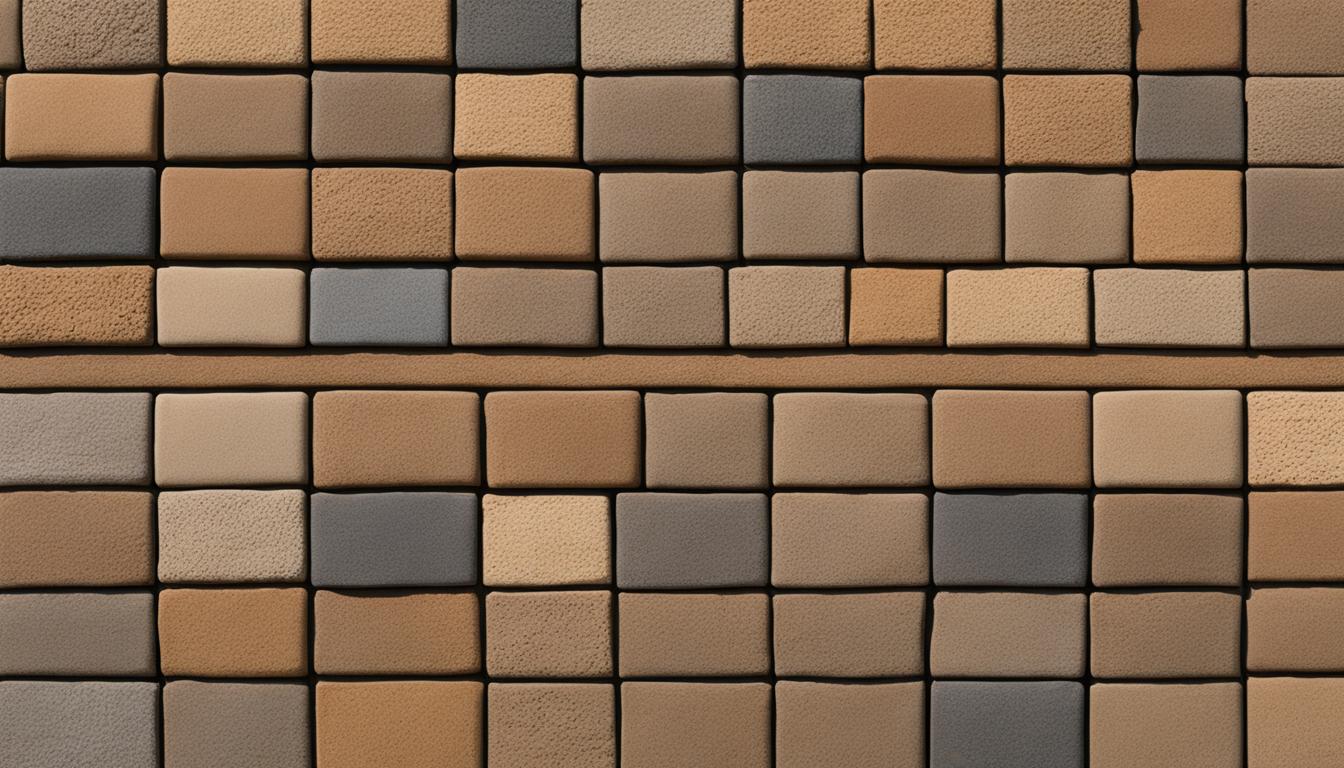When it comes to choosing the right sand for paver joints, I’ve done the research to help you make an informed decision. The type of sand you use in your paver project can significantly impact the stability and longevity of the installation. In this article, I will share my top picks for the best sand options for paver joints and provide valuable insights that can guide your selection process.
Key Takeaways:
- Polymeric sand is the best choice for filling paver joints due to its strength and durability.
- Using polymeric sand prevents movement and weed growth, ensuring a long-lasting paver installation.
- Consider factors such as drying time, consistency, and type of sand when selecting the best option for your project.
- Professional installation is crucial for proper alignment and stability of paver joints.
- Regular maintenance is necessary to keep paver joints filled with sand in optimal condition.
Importance of Polymeric Sand for Paver Joints
Polymeric sand plays a crucial role in ensuring the stability and longevity of paver installations. Unlike traditional sand, polymeric sand offers numerous benefits for filling paver joints, making it the preferred choice for hardscape projects.
One of the key advantages of using polymeric sand is its ability to create a solid seal between pavers. This seal prevents movement, keeping your paver installation intact and reducing the need for frequent repairs. Additionally, the solid seal formed by polymeric sand acts as a barrier, effectively preventing weed growth and minimizing the chances of insect infestation.
What sets polymeric sand apart is its water-activated polymer coating. When activated, this coating binds the sand particles together, creating a strong and durable joint. This enhanced joint strength allows polymeric sand to withstand various weather conditions, including heavy rain and freezing temperatures, without cracking or eroding. As a result, your paver joints remain stable and visually appealing for years to come.
The Benefits of Using Polymeric Sand for Paver Joints:
- Strong seal that prevents movement
- Reduces weed growth
- Minimizes insect infestation
- Water-activated polymer coating for enhanced joint strength
- Durable and weather-resistant
- Long-lasting stability and visual appeal
With its multiple advantages, polymeric sand proves to be an indispensable component for successful paver installations. By utilizing polymeric sand for your paver joints, you can ensure a solid, weed-free, and visually pleasing hardscape project that stands the test of time.
Factors to Consider When Choosing Sand for Paver Joints
When it comes to selecting sand for your paver joints, there are several important factors to consider. Ensuring that you choose the right sand is crucial for the stability and longevity of your paver installation. Here are the key considerations to keep in mind:
1. Type of Sand
The type of sand you choose will depend on your specific needs and preferences. Some common types of sand for paver joints include:
- Polymeric Sand
- Masonry Sand
- Concrete Sand
- Quarry Sand
2. Consistency
The consistency of the sand is an important factor to consider. You’ll want to choose sand that is fine and uniform in texture, ensuring that it can easily fill the joints between the pavers without leaving gaps or voids.
3. Drying Time
The drying time of the sand is another crucial consideration. Depending on your project timeline, you’ll want to select sand that dries quickly and effectively, allowing you to move forward with the next steps of your paver installation.
4. Compatibility
Make sure that the sand you choose is compatible with the type of pavers you are working with. Different paver materials may require specific types of sand to ensure proper adhesion and stability.
5. Weed Prevention
Consider selecting sand that has weed-prevention properties. Some sands are specially formulated to inhibit weed growth, keeping your paver joints clean and weed-free over time.
6. Color
If aesthetics are important to you, you may want to choose sand that complements the color of your pavers. This allows you to create a cohesive and visually appealing look in your outdoor space.
| Type of Sand | Consistency | Drying Time | Compatibility | Weed Prevention | Color Options |
|---|---|---|---|---|---|
| Polymeric Sand | Fine and uniform | Quick drying | Compatible with most paver materials | Weed-inhibiting properties | Various color options available |
| Masonry Sand | Coarse | Typically slower drying | Compatible with most paver materials | No weed prevention properties | Natural color |
| Concrete Sand | Fine and uniform | Quick drying | Compatible with most paver materials | No weed prevention properties | Natural color |
| Quarry Sand | Coarse | Varies | Compatible with most paver materials | No weed prevention properties | Natural color |
By considering these factors when choosing sand for your paver joints, you can ensure a successful and long-lasting paver installation. Take the time to evaluate your needs and preferences, and select the sand that best suits your project requirements.

Top Considerations for Choosing Polymeric Sand for Paver Joints
When it comes to selecting polymeric sand for your paver joints, there are several important factors to consider. These considerations will help you make an informed decision and ensure the success of your hardscape project. Here are some tips to guide you in choosing the right polymeric sand:
- Joint Width: Consider the width of your paver joints when selecting polymeric sand. Different brands and types of polymeric sand have specific recommendations for joint widths. Be sure to choose a product that is suitable for the width of your paver joints to ensure proper performance.
- Color: Polymeric sand comes in various colors to complement different paver designs. Consider the color of your pavers and choose a polymeric sand color that matches or enhances their appearance. This attention to detail will result in a visually stunning hardscape project.
- Durability: Look for polymeric sand that offers excellent durability. It should be resistant to weather conditions, including freeze-thaw cycles, and able to withstand heavy foot traffic and vehicle loads without cracking or disintegrating.
- Application Ease: Consider the ease of application when choosing polymeric sand. Look for products that are easy to spread and adjust during the installation process. This will make your project more efficient and save you valuable time and effort.
- Activation Method: Polymeric sand can be activated with water or used with a dry application method. Consider your preferences and the specific requirements of your project when selecting the activation method. It is important to choose a method that aligns with your installation process.
“Choosing the right polymeric sand is crucial for the success and longevity of your paver joints. Consider the joint width, color, durability, application ease, and activation method to ensure optimal performance and a visually appealing hardscape.”
By taking these considerations into account, you can confidently select the polymeric sand that best suits your project’s needs. Remember, choosing the right polymeric sand is key to achieving long-lasting and beautiful paver joints.
Expert Recommendations on Polymeric Sand Choices for Paver Joints
When it comes to selecting the right polymeric sand for paver joints, experts have identified a range of top recommendations. These polymeric sands offer exceptional joint stability, durability, and weed prevention, ensuring your paver installation remains intact for years to come. Here are the expert-recommended polymeric sands:
| Brand | Product | Features |
|---|---|---|
| 1. Techniseal | Polymeric Sand HP | – Advanced polymer technology – Superior water-activated binder – Excellent resistance to erosion and washout |
| 2. Alliance Gator | Gator Super Sand Bond | – Heavy-duty formula – Fast-setting properties – Enhanced flexibility and strength |
| 3. Sakrete | PermaSand Polymeric Joint Sand | – Self-healing capabilities – Paver movement resistance – Environmentally friendly composition |
| 4. Quikrete | PowerLoc Jointing Sand | – Low-dust formula – High water resistance – Crack-resistant technology |
| 5. SEK-Surebond | Techniseal Polymeric Sand RG+ | – Rapid-setting properties – Enhanced bond strength – Stabilizes pavers in various climates |
These expert-recommended polymeric sands have been carefully selected based on their performance, quality, and ease of use. Consider the specific features and benefits of each product to find the polymeric sand that best suits your paver joint needs. With these top recommendations, you can confidently enhance the longevity and visual appeal of your paver installation.
Additional Recommendations for Polymeric Sand Choices
Aside from the top recommended polymeric sands for paver joints, there are other options worth considering. These additional polymeric sands offer alternative features and benefits that may suit your specific project needs.
- Polymeric Sand X: This premium-grade polymeric sand combines excellent joint stabilization with enhanced color retention. Its advanced formula prevents weed growth and erosion, ensuring long-lasting stability for your paver joints. With a wide range of color options available, Polymeric Sand X allows you to add a personalized touch to your hardscape design.
- Polymeric Sand Y: Ideal for larger joints, Polymeric Sand Y provides superior strength and durability. Its high-performance formulation ensures optimal bonding and stability, even in high-traffic areas. The self-healing properties of Polymeric Sand Y help to maintain the integrity of the joints over time, reducing the need for frequent maintenance.
- Polymeric Sand Z: If you’re looking for polymeric sand that offers both joint stabilization and enhanced water resistance, Polymeric Sand Z is an excellent choice. Its unique formula creates a water-repellent barrier that helps to prevent moisture absorption and mold growth. Polymeric Sand Z is particularly suitable for areas with heavy rainfall or high humidity.
Remember, choosing the right polymeric sand is essential for achieving long-lasting and visually appealing paver joints. Consider these additional recommendations and select the option that best meets your specific project requirements.
| Polymeric Sand | Features | Benefits |
|---|---|---|
| Polymeric Sand X | Excellent joint stabilization Enhanced color retention |
Prevents weed growth and erosion Offers personalized color options |
| Polymeric Sand Y | Superior strength and durability Ideal for larger joints |
Ensures stability, even in high-traffic areas Reduces maintenance needs |
| Polymeric Sand Z | Joint stabilization Enhanced water resistance |
Prevents moisture absorption and mold growth Suitable for areas with heavy rainfall or high humidity |
Importance of Creating a Strong Base with Sand for Paver Joints
Creating a strong base with sand is of utmost importance when it comes to ensuring the stability and longevity of your paver installation. By establishing a solid foundation, you can prevent issues such as shifting, sinking, and damage caused by foot and vehicle traffic. Let’s explore the benefits of creating a strong base with sand:
- Level Surface: A strong base with sand provides a level surface for your pavers, ensuring a smooth and uniform appearance.
- Prevents Shifting and Sinking: By properly compacting the sand, you can prevent your pavers from shifting or sinking over time, maintaining the integrity of your paver installation.
- Enhances Load-Bearing Capacity: A strong base improves the load-bearing capacity of your pavers, allowing them to withstand heavy foot traffic and even vehicle loads without suffering damage.
- Distributes Weight Evenly: With a well-built base, the weight placed on your pavers is distributed evenly, reducing the risk of cracks and uneven settling.
To visually illustrate the importance of a strong base with sand for paver joints, take a look at the following table:
| Without a Strong Base | With a Strong Base |
|---|---|
| Pavers may shift or sink over time. | Pavers remain stable and in place. |
| Uneven surface and potential tripping hazards. | Level and uniform appearance. |
| Increased risk of cracks and damage. | Enhanced load-bearing capacity, preventing damage from foot and vehicle traffic. |
By creating a strong base with sand for your paver joints, you can ensure the long-term durability and visual appeal of your paver project. Now let’s proceed to the next section for more insights on using concrete sand as the ideal base for paver joints.
Use of Concrete Sand as the Ideal Base for Paver Joints
Concrete sand is widely recognized as the ideal base for paver joints due to its exceptional durability and quality. When used as the foundation for paver installations, concrete sand provides a stable base that helps maintain the integrity of the entire project.
The mixture of cement and concrete sand creates a strong and compact base that can withstand the pressure exerted by the pavers and various external factors. This robust base ensures the longevity and stability of the paver project, offering a solid structure that can endure heavy loads and frequent use.
By using concrete sand as the ideal base for paver joints, you can rest assured that your pavers will remain securely in place without shifting or sinking over time. The reliable support provided by the concrete sand base minimizes the risk of uneven settling and ensures a level surface that enhances both the aesthetic appeal and functionality of your outdoor space.

Whether you’re installing pavers for a patio, driveway, or walkway, choosing concrete sand as your base is a smart choice that guarantees long-term results. Its exceptional strength and stability make it an essential component in achieving a professional and enduring paver installation.
Step-by-Step Guide for Creating a Base with Sand for Paver Joints
Creating a strong base with sand is crucial for the stability and longevity of your paver joints. Follow these step-by-step instructions to ensure a solid foundation:
- Excavate the area: Begin by excavating the area where you want to install your pavers. Dig down to a depth of at least 6 inches to allow space for the base layer and sand.
- Level the foundation: Use a rake or a shovel to level the excavated area, ensuring a smooth and even surface. Remove any rocks, debris, or vegetation to prevent future settling.
- Compact the soil: Use a plate compactor or a hand tamper to compact the soil firmly. This step is crucial for creating a stable and solid base.
- Add a geotextile fabric: Lay a geotextile fabric over the compacted soil to prevent weed growth and promote proper drainage.
- Add the base material: Spread a layer of crushed limestone or concrete sand over the geotextile fabric. The base material should be approximately 4 inches thick.
- Compact the base: Use a plate compactor to compact the base material, ensuring it is firmly packed. This step will further enhance the stability of your paver joints.
- Add a layer of bedding sand: Spread a layer of fine, evenly graded sand over the compacted base material. The bedding sand should be approximately 1 inch thick.
- Level the sand: Use a screed board or a long, straight piece of lumber to level the bedding sand. Move the screed board back and forth in a sawing motion to create a smooth and level surface.
- Compact the sand: Once the sand is leveled, use a plate compactor to compact it gently. This step helps to ensure a solid and stable base for your paver joints.
- Check the level: Use a level or a straightedge to check the overall level of the sand surface. Make any necessary adjustments to ensure a uniform height for your pavers.
By following these step-by-step instructions, you can create a strong and stable base with sand for your paver joints. This solid foundation will support your pavers and provide long-lasting durability for your hardscape project.

Importance of Professional Installation for Paver Projects
Professional installation plays a critical role in the success of any paver project. Hiring professionals for paver installation offers a range of benefits that ensure proper alignment, stability, and longevity for your outdoor space.
One of the main advantages of professional installation is the expertise that professionals bring to the table. They have extensive knowledge and experience in working with pavers, allowing them to make informed decisions and execute the installation with precision. Professionals also possess specialized tools that enable them to create a strong base with sand for paver joints, minimizing the risk of any movement or shifting of the pavers over time.
When you hire professionals for your paver installation, you can be confident that the pavers will be installed correctly, with proper joint spacing and compaction. This ensures optimal stability for your hardscape, preventing issues such as uneven settling or cracks. By avoiding costly mistakes, professional installation saves you time and money in the long run, reducing the need for repairs or replacements.
Another advantage of professional installation is the guarantee of a high-quality and visually appealing paver project. Professionals pay attention to every detail, ensuring that the pavers are installed evenly and accurately. They have an eye for design and can recommend the best layout and patterns that complement your outdoor space. With their expertise, you can achieve a beautiful and functional hardscape that enhances the overall aesthetics of your home.
Consider professional installation for your paver project to ensure a seamless and long-lasting result. By entrusting the job to experts, you can enjoy peace of mind knowing that your outdoor space will be transformed into a durable and visually appealing area for you and your family to enjoy.

Maintenance Tips for Paver Joints Filled with Sand
To ensure the longevity and beauty of your paver joints filled with sand, it is important to follow these maintenance tips:
Regular Cleaning
To prevent the buildup of debris and weeds in the paver joints, it is essential to regularly clean the surface. Use a broom or leaf blower to remove leaves, dirt, and other loose particles. For stubborn dirt or stains, a pressure washer can be used with caution, taking care not to dislodge the sand from the joints.
Inspect and Refill
Periodically inspect the paver joints to check for any signs of erosion or loss of sand. If you notice gaps or low areas, refill them with additional sand. Make sure to use the same type of sand that was initially used for the joints to maintain consistency.
Weed Control
To prevent weed growth in the paver joints, apply a weed control product specifically formulated for use on paver surfaces. Follow the manufacturer’s instructions and reapply the product as necessary to keep weeds at bay.
Polymeric Sand Activation
If you have used polymeric sand for your paver joints, activating the polymer coating is crucial for its effectiveness. Thoroughly water the paver surface, ensuring the water reaches the joints. Allow the sand to dry completely, and repeat the process if necessary to activate the polymer binding agents.
Sealing the Joints
Consider applying a sealer to the paver joints to provide an additional layer of protection. The sealer helps to repel water and prevent stains, keeping the sand in place and reducing the risk of erosion.
Regular Inspections
Perform regular inspections of your paver joints to identify any issues or signs of wear. Addressing minor problems early on can help prevent major repairs and ensure the longevity of your paver installation.
By following these maintenance tips, you can keep your paver joints filled with sand in optimal condition, enhancing the overall beauty and durability of your outdoor space.
| Maintenance Tips for Paver Joints Filled with Sand |
|---|
| Regular Cleaning |
| Inspect and Refill |
| Weed Control |
| Polymeric Sand Activation |
| Sealing the Joints |
| Regular Inspections |
Conclusion
Selecting the right sand for paver joints is crucial for the stability and longevity of your paver project. After careful consideration, I recommend polymeric sand as the best option for filling paver joints. Its exceptional joint sealing properties and durability make it the top choice in the market.
When choosing sand for paver joints, take into account factors such as the type of sand, consistency, and drying time. Polymeric sand comes in various colors, allowing for customization to match your aesthetic preferences. It is essential to follow expert recommendations for selecting polymeric sand, as they have identified the top picks based on their performance and reliability.
In addition to selecting the right sand, creating a strong base with sand is a key aspect of a successful paver installation. By providing stability and preventing shifting or sinking of the pavers, a strong base enhances the overall durability and load-bearing capacity of your paver project. Consider professional installation to ensure proper alignment and compaction of the sand base.
With proper maintenance, your paver joints filled with sand will remain stable and visually appealing for years to come. Follow recommended care guidelines to protect the integrity of the sand-filled joints and prevent weed growth or erosion. By making informed and selection choices and implementing proper maintenance practices, you can ensure your paver joints withstand the test of time and provide a beautiful outdoor space.
FAQ
What type of sand is best for filling paver joints?
Polymeric sand is the best type of sand for filling paver joints. It forms a strong and durable joint, preventing movement and weed growth.
What are the benefits of using polymeric sand for paver joints?
Polymeric sand creates a solid seal that prevents movement, weed growth, and insect infestation. It also withstands various weather conditions, ensuring a long-lasting and visually appealing hardscape project.
What factors should I consider when choosing sand for paver joints?
When selecting sand for paver joints, consider factors such as type of sand, consistency, and drying time. These factors will affect the overall stability and longevity of your paver installation.
Do you have any recommendations for polymeric sand choices for paver joints?
Experts recommend polymeric sands such as Sakrete Paver Set and Techniseal HP2 Polymeric Sand for paver joints. These polymeric sands offer excellent joint sealing and durability.
Are there any additional polymeric sand options for paver joints?
Other polymeric sand options for paver joints include Alliance Gator Super Sand, Polybind Polymeric Sand, and Black Diamond Stoneworks Wet Look Joint Sand. These sands provide additional customization and versatility for your paver project.
Why is creating a strong base with sand important for paver joints?
Creating a strong base with sand is vital for the stability and durability of the paver installation. It provides a level surface, prevents shifting or sinking, improves load-bearing capacity, and reduces the risk of cracks and uneven settling.
Why is concrete sand considered the ideal base for paver joints?
Concrete sand is considered the ideal base for paver joints due to its durability and quality. It creates a strong and compact base that can withstand the pressure exerted by the pavers and external factors, ensuring the longevity and stability of the paver project.
What are the steps for creating a strong base with sand for paver joints?
Follow these steps to create a strong base with sand for paver joints:
1. Excavate the area and remove any existing materials.
2. Compact the soil to ensure stability.
3. Add a layer of geotextile fabric to prevent weed growth.
4. Spread a layer of concrete sand evenly and compact it thoroughly.
5. Check for levelness and adjust if necessary.
6. Repeat the compaction process until you achieve a solid base.
7. Install the pavers on top of the sand base, leaving the appropriate joint spacing.
Why is professional installation important for paver projects?
Professional installation is crucial for paver projects to ensure proper alignment, stability, and longevity. Professionals have the knowledge, experience, and specialized tools to create a strong base with sand, preventing any movement or shifting of the pavers. Their expertise ensures that the pavers are installed correctly, with proper joint spacing and compaction, resulting in a high-quality and visually appealing paver project.
How should I maintain paver joints filled with sand?
To maintain paver joints filled with sand, regularly sweep and remove debris to prevent weed growth. Additionally, reapply polymeric sand every few years or as needed to ensure the integrity of the joints.

